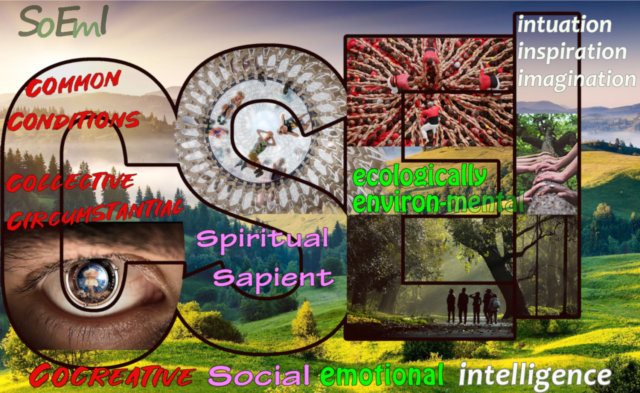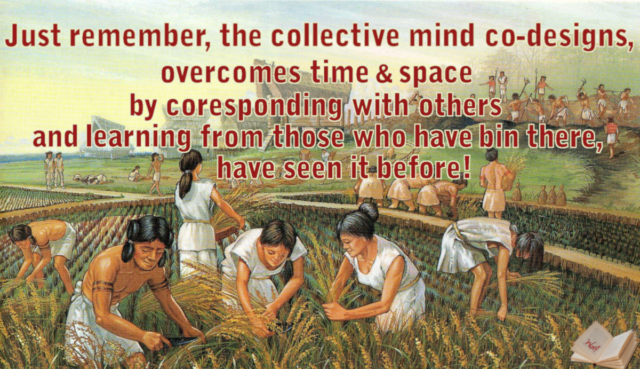To correspond & interact with this eco-dynamic of our habitat, our species must cultivate a new way of thinking
that aligns with our world’s interconnected, dynamic, and ever-evolving nature.
This paradigm shift calls for a move away from rigid, linear, and hierarchical structures – both in thought and action –
toward a more fluid, relational, and systems-oriented approach. It’s about recognizing that life is not a series of
isolated events or dominions to be conquered, but a web of relationships, feedback loops, and co-creative processes.
– simply, to emulate & biomimic the natural habitat !
The Logical Fallacies of Linear Thinking
For centuries, human progress has been driven by linear, reductionist thinking – breaking problems into
smaller parts, seeking clear cause-and-effect relationships, and prioritizing control and efficiency.
While this approach has fueled technological and industrial advancements, it has also led to
fragmentation, exploitation, and a disconnect from the natural world.
Our linear mindset has created silos – between humans and nature, between individuals and communities and
even within ourselves – separating intellect from emotion, body from mind, and the Self from the Other.
This way of thinking is no longer sustainable. The challenges we face today – climate change,
social inequality, political polarization, and mental health crises – are interconnected and systemic.
They cannot be solved by isolated solutions or top-down hierarchies. Instead, they require a shift
toward non-linear, non-hierarchic thinking that embraces complexity, interdependence, and collaboration.
The Emergence of Non-Linear, Non-Hierarchic Thinking
Non-linear thinking is about seeing patterns, relationships, and possibilities rather than fixed outcomes.
It’s about understanding that small changes can have large, unpredictable effects (the butterfly effect) and
that systems are constantly adapting and evolving. Non-hierarchic thinking, on the other hand, rejects rigid
power structures and embraces distributed, collaborative networks where every voice and perspective has value.
This new paradigm is deeply rooted in ecology – the study of relationships within systems.
Just as ecosystems thrive on diversity, mutualism and resilience, so do human societies.
By developing an eco-dynamic mindset, we can begin to see ourselves,
not as separate from nature, but as integral participants in its web of life.
Reviving our Common Social-Emotional Intelligence (CSEI)
At the heart of this paradigm shift is the revival of Social-Emotional-Intelligence (CSEI)—the ability to understand,
empathize, and collaborate with the Collective while being attuned to our individual emotions and social values.
CSEI is essential for navigating the complexities of our interconnected world. It allows us to :
1. Empathize with ‘the Other’: Recognizing and honoring the experiences, perspectives, and needs of all Beings, fostering
compassion & understanding for ‘the Other’ and nurturing cooperation with the common our socio-ecological environment
2. Collaborate Across Boundaries: Working together across cultural, ideological, and disciplinary divides
by addressing common matters and shared challenges.
3. Adapt to Change: Embrace uncertainty and ambiguity with resilience and creativity, rather than fear or resistance.
4. Cultivate Self-Awareness and your Sense of Agency: Understanding our own emotions, biases and motivations,
enables us to act with integrity and purpose.
CSEI is not just a personal skill; it’s our collective capacity to correspond and coexist within our ecosystem.
It requires us to move beyond individualism and competition toward a culture of care, reciprocity, and shared responsibility.
Synchronizing with the Eco-Dynamic,
– a new Way of Thinking
To thrive in this new paradigm, we must attune & harmonize our thinking and coordinate our behavior with the principles of eco-dynamics:
1. Interdependence: Recognize that all life is interconnected and that our well-being is tied to the health of the whole.
2. Diversity: Celebrate and protect the diversity of life, ideas, and cultures as a source of resilience and innovation.
3. Regeneration: Shift from exploitation and consumption to regeneration and restoration; creating systems that maintain
flexibility and sustain life rather than deplete it.
4. Adaptability: Embrace change and the plasticity of uncertainty as an opportunity to learn and to widen our ‘horizon’.
5. Synergy: Accept death & decay as part of our maturation and a transformation process rather than the ‘End of the Line’.
Practical Steps Toward the Shift:

























